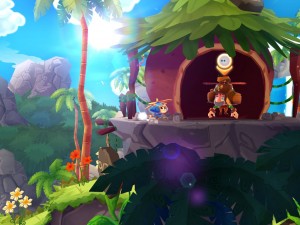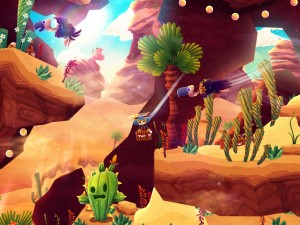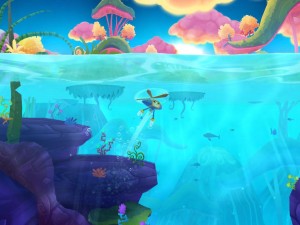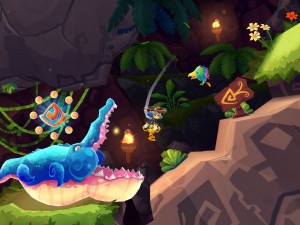Long ago — when the floating kingdom of Levantia was first formed — they were given the Emerix, a stone that would bestow upon them great powers so that they might protect themselves from the world at large. Ironically, this giant mystical stone — which had originally been created for the purpose of keeping Levantia safe — in the end only managed to bring much war and strife to the peaceful kingdom. This was because Doctor N. Forchin — along with the help of assistant: Vapor — waged many bloody campaigns against Levantia, all in the name of seizing the Emerix’s power for their own dark ends.
 You now find yourself taking on the role of a young, propeller-headed, cat-monkey-boy-thing whom — in the midst of his flight training — witnesses the nefarious Doctor N. Forchin finally succeed with his nefarious schemes. Surely a great calamity will befall Levantia — as well as the entire rest of the world — if the Emerix isn’t quickly recovered, but Doctor N. Forchin has already prepared himself to stave off a full-frontal assault. Heroki — with everyone else being unsure how to best proceed forward — volunteers to covertly catch up with the mad doctor and take back the Emerix all by himself, thus leading him on a fantastical adventure across twenty-four different gorgeous stages.
You now find yourself taking on the role of a young, propeller-headed, cat-monkey-boy-thing whom — in the midst of his flight training — witnesses the nefarious Doctor N. Forchin finally succeed with his nefarious schemes. Surely a great calamity will befall Levantia — as well as the entire rest of the world — if the Emerix isn’t quickly recovered, but Doctor N. Forchin has already prepared himself to stave off a full-frontal assault. Heroki — with everyone else being unsure how to best proceed forward — volunteers to covertly catch up with the mad doctor and take back the Emerix all by himself, thus leading him on a fantastical adventure across twenty-four different gorgeous stages.
Thus goes to the premise to Heroki (out now, $7.99), a recently released game by Picomy and SEGA which aims to prove that you really can receive an original high-end platforming experience — utterly unadulterated by IAPs — on mobile devices everywhere. Although I will most assuredly be touching on this again further down, I just want to say right now that Heroki is mind-blowingly beautiful to look at — immediately invoking memories of PS2/GCN era platforming classics — with tiny whimsical details all over. Although I can certainly say with a straight face that Heroki is a positively phenomenal experience — fully worth SEGA’s asking price — there is one major issue preventing me from offering the game a perfect five, which I’ll also be covering much further down.
Anyways — before you can truly begin your quest to recover the Emerix — the first thing you’ll need to do is decide how Heroki’s flight abilities should control, of which you have three major options available. You either use a control scheme where you push him around with your finger (don’t confuse this with dragging), one where he tries to catch up with your finger as you drag it around, and one where you have a virtual analog-joystick. I ended up sticking with the virtual analog-joystick as I had issues with pushing into Heroki correctly (despite Picomy’s staff considering this their best method), and also didn’t like obscuring where I was going via the finger chasing method.
 Despite already being able to freely fly Heroki about in a full 360 degrees of motion, you can additionally command him into an absolute freefall (don’t worry, this isn’t harmful in the slightest). Tapping the screen’s right hand side should initiate this freefall, which can simultaneously be used to either quickly escape precarious situations or to smash your way through breakable cloud-blocks. While falling you may command the direction in which Heroki descends by moving him either left or right, or you may alternatively bring this fall to an abrupt halt by commanding him to move upwards at any time.
Despite already being able to freely fly Heroki about in a full 360 degrees of motion, you can additionally command him into an absolute freefall (don’t worry, this isn’t harmful in the slightest). Tapping the screen’s right hand side should initiate this freefall, which can simultaneously be used to either quickly escape precarious situations or to smash your way through breakable cloud-blocks. While falling you may command the direction in which Heroki descends by moving him either left or right, or you may alternatively bring this fall to an abrupt halt by commanding him to move upwards at any time.
As fun as flying and falling all over the place can be — which actually isn’t a sarcastic statement — sometimes you’re still going to need a way to deal with your foes, and that’s where Heroki’s many loose crates and boulders come into play. Tapping an object will instruct Heroki to scoop it up, after which — unless you bang into something carelessly — the crate/boulder will remain in his hands as he flies to and fro about the current level. Although tapping on held items causes them to fall straight down — which can certainly be useful at times — you can additionally hurl objects by tapping on Heroki and then dragging you finger away, causing a weaponized slingshot effect similar to Angry Birds.
Finally — although only rarely needed — you may instruct Heroki to land upon the ground by leaving him idling near a surface, after which you can command him to walk about by tilting your entire iDevice either left or right. Normally this option — due to how flying is both fun and immensely useful — will generally serve as little more than a novelty of sorts, although walking around is not entirely devoid of value. Sometimes Heroki will find narrow pathways — either containing hidden treasures, or perhaps necessary switches — that he can’t fly into with his propellers out, yet otherwise can be walked into with ease.
 Using these controls you’ll have to traverse across twenty-four levels before you may finally confront the nefarious Doctor N. Forchin, but — being just a little boy — you’ll first need to power up if you hope to ever have any chance at stopping the maniacal overlord. It is for this reason that Levantia’s king has asked you to seek out two of his friends — whom just so happen to live down below — before tackling the grand mastermind, yet these two vital mentors can’t simply aid Heroki for free. Our hero, in order to learn new abilities, will need to find numerous Emirals — which seem to be stones of great power, yet far weaker than the almighty Emerix — that have been strewn all over the place.
Using these controls you’ll have to traverse across twenty-four levels before you may finally confront the nefarious Doctor N. Forchin, but — being just a little boy — you’ll first need to power up if you hope to ever have any chance at stopping the maniacal overlord. It is for this reason that Levantia’s king has asked you to seek out two of his friends — whom just so happen to live down below — before tackling the grand mastermind, yet these two vital mentors can’t simply aid Heroki for free. Our hero, in order to learn new abilities, will need to find numerous Emirals — which seem to be stones of great power, yet far weaker than the almighty Emerix — that have been strewn all over the place.
Each labyrinthine level that Heroki traverses across will contain precisely five hidden Emirals to discover; these will be located either in out of the way places, or sometimes even behind tricky false-wall sections. Tracking down every last one of these Emirals can actually take — especially due to Heroki’s free-roaming 360 degree nature — quite a bit of time to complete, but should certainly please fans of classic 16-bit era RARE releases. There’s additionally a ton of other collectables that you can optionally strive to track down across all twenty-four of Heroki’s varied stages, but not one of these other objects are ever explicitly required.
With the requisite number of Emirals collected — and the end of a level-set reached (of which three exist) — a new power can be unlocked, such as Heroki gaining the ability to direct the wind’s flight path. All you have to do is first draw a line — of any particular shape you’d prefer — starting from the screen’s edge, after which a mighty gale will rip across the lands — easily blowing around obstacles and stuff — precisely as you directed. Although Heroki claims that you merely need to start drawing this line at your screen’s edge, I would personally advise that you should actually start this process — in order to avoid the game becoming quite confused — somewhere before the screen has even begun.
 Now at this point in the review you might — based on what I previously stated — be wondering just exactly how the other shoe is going to drop, what could possibly make me less than perfectly delighted with Heroki? Although some people have commented how the freedom of flight can easily lead you into hitting off-screen enemies if you take off at full-tilt, I actually consider this to be a legitimate part of the game’s old school charm. Back in the day video games used to not only feature whimsical graphics — cute themes — and utterly bizarre premises, they also tended to be 100% soul-crunchingly brutal (despite otherwise seeming as though they were built with rather young children in mind).
Now at this point in the review you might — based on what I previously stated — be wondering just exactly how the other shoe is going to drop, what could possibly make me less than perfectly delighted with Heroki? Although some people have commented how the freedom of flight can easily lead you into hitting off-screen enemies if you take off at full-tilt, I actually consider this to be a legitimate part of the game’s old school charm. Back in the day video games used to not only feature whimsical graphics — cute themes — and utterly bizarre premises, they also tended to be 100% soul-crunchingly brutal (despite otherwise seeming as though they were built with rather young children in mind).
My complaint doesn’t actually derive from any particular part of Heroki’s mechanics — levels — or visuals, but rather in how the game seems to be a little bit ill-suited to the platform it was launched upon. When people consider mobile gaming they think of freedom, versatility, shorter sessions aiming to fill otherwise wasted pockets of time, and basically everything else that goes along with the pick-up-and-play mentality. Although iOS devices are 100% capable of running Heroki flawlessly enough — without either constant crashing, or bouts of slowdown — it fails to fit the game on this conceptual level.
The levels in the game are frequently long and often confusing to traverse, although — given the app’s deliberate theme of exploration — I think this was probably done deliberately by Picomy’s staff. The time required to finish a level — especially with all five Emirals in tow — is then further exacerbated by the difficulty that I previously mentioned, which actively discourages you from rushing into new locales at mach nine. This would probably be all well and good — since, as previously mentioned, I actually respect Heroki’s retro difficulty — but is sadly ruined by the fact that you’re only allowed to save at the end of each level.
 Although this probably goes without saying: is anyone here aware of what game sessions tend to do after your iOS device enters sleep mode (especially when the app is of a complicated nature)? You get a gold star if you answered that the game tends to simply crash, which is quite the dilemma when many of Heroki’s later levels can easily take far longer than one could ever reasonably expect to have during a mobile gaming session. While sitting down at the couch is certainly always a viable option, most people would rather reach for their PC — a portable device (such as the 3DS or PSP-Vita) — or even a full blown gaming console once they’ve arrived back home.
Although this probably goes without saying: is anyone here aware of what game sessions tend to do after your iOS device enters sleep mode (especially when the app is of a complicated nature)? You get a gold star if you answered that the game tends to simply crash, which is quite the dilemma when many of Heroki’s later levels can easily take far longer than one could ever reasonably expect to have during a mobile gaming session. While sitting down at the couch is certainly always a viable option, most people would rather reach for their PC — a portable device (such as the 3DS or PSP-Vita) — or even a full blown gaming console once they’ve arrived back home.
This won’t — however — necessarily make it impossible to play Heroki on your iOS based device of choice, but it certainly can make things a tad inconvenient for anyone used to playing games on the go. That said — despite the inconvenience this represents — it’s additionally worth pointing out that this will probably be Heroki’s only release ever, seeing as how SEGA recently declared themselves to be mobile only. So should Heroki interest you — and you’re willing to bite the bullet regarding the game’s longer levels — you might as well just buy it, since future other-platform releases are rather unlikely.
Either way — inconvenience matters aside — it’s high time I finally began discussing how Heroki appears visually, seeing as how that’s actually a major component of the game’s overall appeal. This game is — to put it rather simply — absolutely stunning to look at, and the utterly stationary screenshots littered about this review don’t really manage to do Heroki proper justice. The game is bright — cheerful — and all around whimsical (you can solve a puzzle by being shot from a whale’s blowhole), in the process managing to feel as though you’ve found a lost classic from the PS2/GCN era of 3D platforming adventures.
 Perhaps the best example of all this would have to be Levantia: Heroki’s home village (although the game’s extremely lavish stages, filled to the brim with various little details, are certainly great too). Here you may — for no real reason — freely meander amongst the many denizens (all praying for the Emerix’s safe return), and possibly even engage in a few mini-games along the way. Although you have a teleportation map — which enables fast travel to any Levantian point of interest — you wouldn’t believe how much time I wasted within just this one locale, personally flying to and fro as I took in all the sights.
Perhaps the best example of all this would have to be Levantia: Heroki’s home village (although the game’s extremely lavish stages, filled to the brim with various little details, are certainly great too). Here you may — for no real reason — freely meander amongst the many denizens (all praying for the Emerix’s safe return), and possibly even engage in a few mini-games along the way. Although you have a teleportation map — which enables fast travel to any Levantian point of interest — you wouldn’t believe how much time I wasted within just this one locale, personally flying to and fro as I took in all the sights.
Ultimately — for some of you — Heroki’s only real deterrent will be its rather hefty $7.99 upfront price tag, which is certainly somewhat high when compared to most other mobile experiences available. However — before you write Heroki off like that — you should first consider that this entire lengthy experience comes with nary an IAP in sight, nor was it balanced in a way that suggests they’ll arrive in the near future either. Assuming that you’re already willing to deal with the conundrum presented by Heroki’s rather lengthy levels, then I’m personally willing to guarantee this was worth every last cent asked for.
iFanzine Verdict: Heroki is a visually impressive sidescrolling experience — full of much graphical whimsy — that tasks you with exploring twenty-four different levels, with the primary tool available being your unlimited ability to fly about in 360 degrees. Your requirement to find five different Emirals hidden across each level — amongst many other collectables, although the others aren’t inherently necessary — lends the game a sense of exploration similar to many long ago releases designed by RARE. About the only real downside here is that the long nature of Heroki’s levels — coupled with a difficulty that isn’t afraid to backhand you for going too fast — means that this game takes quite a while to play through, and you can only save after each level’s end.


